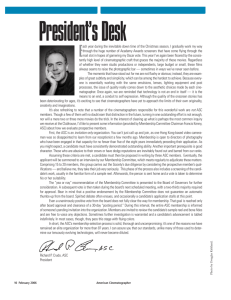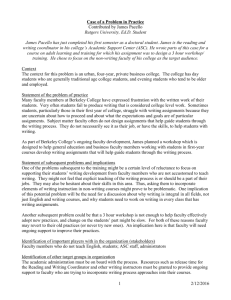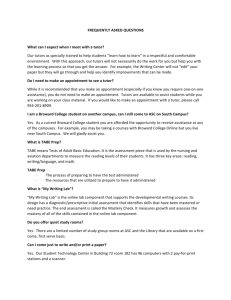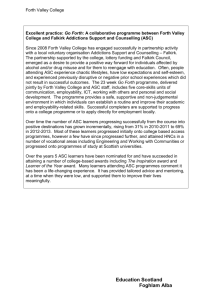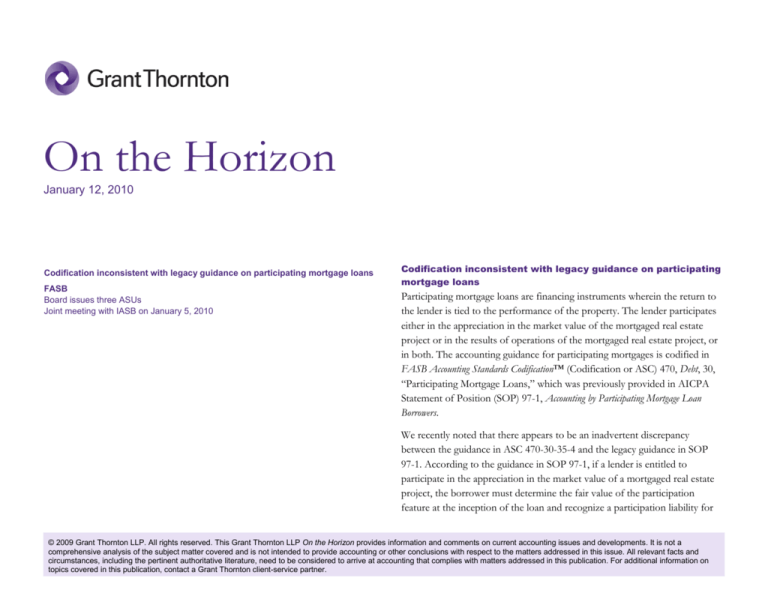
On the Horizon
January 12, 2010
Codification inconsistent with legacy guidance on participating mortgage loans
FASB
Board issues three ASUs
Joint meeting with IASB on January 5, 2010
Codification inconsistent with legacy guidance on participating
mortgage loans
Participating mortgage loans are financing instruments wherein the return to
the lender is tied to the performance of the property. The lender participates
either in the appreciation in the market value of the mortgaged real estate
project or in the results of operations of the mortgaged real estate project, or
in both. The accounting guidance for participating mortgages is codified in
FASB Accounting Standards Codification™ (Codification or ASC) 470, Debt, 30,
“Participating Mortgage Loans,” which was previously provided in AICPA
Statement of Position (SOP) 97-1, Accounting by Participating Mortgage Loan
Borrowers.
We recently noted that there appears to be an inadvertent discrepancy
between the guidance in ASC 470-30-35-4 and the legacy guidance in SOP
97-1. According to the guidance in SOP 97-1, if a lender is entitled to
participate in the appreciation in the market value of a mortgaged real estate
project, the borrower must determine the fair value of the participation
feature at the inception of the loan and recognize a participation liability for
© 2009 Grant Thornton LLP. All rights reserved. This Grant Thornton LLP On the Horizon provides information and comments on current accounting issues and developments. It is not a
comprehensive analysis of the subject matter covered and is not intended to provide accounting or other conclusions with respect to the matters addressed in this issue. All relevant facts and
circumstances, including the pertinent authoritative literature, need to be considered to arrive at accounting that complies with matters addressed in this publication. For additional information on
topics covered in this publication, contact a Grant Thornton client-service partner.
On the Horizon January 12, 2010
that amount, with a corresponding debit to a debt discount. The debt discount
must be amortized using the effective interest rate method and included in
interest expense. At the end of each reporting period, the balance of the
participation liability must be adjusted to equal the current fair value of the
participation feature, with a corresponding debit or credit to the debt discount,
and the revised amount of debt discount is then amortized prospectively.
If a lender participates in the results of operations of a mortgaged real estate
project, the borrower does not recognize a participation liability at the loan’s
inception. Instead, participation amounts due to a lender from the results of
operations are charged to interest expense in the corresponding financial
reporting period, with a corresponding credit to the participation liability.
In contrast, the guidance in ASC 470-30-25-1 appears to require recognition of
a liability at inception for both types of participation features. This difference is
a result of redrafting the applicability language in SOP 97-1, and it seems that
the Codification has inadvertently made a change in U.S. GAAP.
The FASB staff has been notified and concurred with this assessment. The staff
indicated that it will propose a technical amendment to the Codification in due
course. Because the intent of the Codification was not to change U.S. GAAP,
we believe that entities should continue to follow the guidance of SOP 97-1
when accounting for participating mortgages until the Codification is amended.
Accounting for distributions to shareholders with components of stock and
cash
ASU 2010-01, Accounting for Distributions to Shareholders with
Components of Stock and Cash – a consensus of the FASB Emerging Issues
Task Force, clarifies the accounting treatment for a stock portion of a
shareholder distribution that (1) contains both cash and stock components,
(2) allows shareholders to select their preferred form of the distribution, and
(3) limits the total amount of cash to be distributed. Under the new guidance,
which amends ASC 505, Equity, the stock portion of qualifying distributions
must be treated as a stock issuance and be reflected prospectively in the
calculation of earnings per share (EPS).
Additionally, the new guidance amends the definition of a stock dividend in
the ASC Master Glossary to clarify that a stock dividend takes nothing from
the property of an entity and adds nothing to the interests of an entity’s
shareholders because the proportional interest of each shareholder remains
the same. ASU 2010-01 represents the EITF’s consensus on EITF Issue 09E, “Accounting for Distributions to Shareholders with Components of Stock
and Cash.”
The amendments to ASC 505 in ASU 2010-01 are effective for interim and
annual periods ending on or after December 15, 2009 and require
retrospective application.
Accounting and reporting for decreases in ownership of a subsidiary
FASB
Board issues three ASUs
The FASB recently issued three Accounting Standards Updates (ASUs),
described below, to address (1) distributions to shareholders with stock and
cash components, (2) accounting and reporting on decreases in ownership, and
(3) reporting reserves and disclosures for oil and gas entities.
ASU 2010-02, Accounting and Reporting for Decreases in Ownership of a Subsidiary—
a Scope Clarification, clarifies which transactions are subject to the decrease in
ownership provisions in ASC 810-10, Consolidation (formerly FASB Statement
160, Noncontrolling Interests in Consolidated Financial Statements).
The existing guidance in ASC 810-10 requires a parent to deconsolidate a
subsidiary on the date the parent ceases to have a controlling financial interest
2
On the Horizon January 12, 2010
in the subsidiary. In a deconsolidation that is not a nonreciprocal transfer to
owners, the former parent recognizes a gain or loss on the transaction and
measures any retained investment in the former subsidiary at fair value.
The amendments in ASU 2010-02 clarify that the decrease in ownership
provisions in ASC 810-10, including the deconsolidation provisions, apply only
to the following:
•
•
•
•
ASC 605, Revenue Recognition
•
ASC 845, Nonmonetary Transactions
•
ASC 860, Transfers and Servicing
•
A subsidiary or group of assets that is a business or nonprofit activity and is
transferred to an equity method investee or joint venture
ASC 932, Extractive Activities – Oil and Gas, on conveyances of mineral
rights and related transactions
•
An exchange of a group of assets that constitutes a business or nonprofit
activity for a noncontrolling interest in an entity, including an equity
method investee or joint venture
ASC 360, Property, Plant, and Equipment, and ASC 976, Real Estate—
Retail Land, on sales of in substance real estate
If other guidance does not exist, an entity must then apply the guidance in
ASC 810-10 to account for the transaction.
A subsidiary or group of assets that constitutes a business or nonprofit
activity
In addition, the decrease in ownership provisions do not apply if the transaction
resulting in an entity’s decreased ownership interest is either
•
•
Entities must evaluate the substance of a decrease in ownership transaction of
a subsidiary that is not a business or nonprofit activity and determine whether
there is applicable guidance outside ASC 810-10, including but not limited to
the following:
The sale of in substance real estate. Such transactions must instead be accounted
for under the real estate sale guidance in ASC 976, Real Estate—Retail Land,
605, “Revenue Recognition” (formerly FASB Statement 66, Accounting for
Sales of Real Estate), or ASC 360, Property, Plant, and Equipment, 20, “Real
Estate Sales” (formerly EITF Issue 00-13, “Determining Whether
Equipment Is ‘Integral Equipment’ Subject to FASB Statements No. 66
and No. 98”).
The conveyance of oil and gas mineral rights. Such a transaction would be
accounted for in accordance with the guidance on mineral rights
conveyances and related transactions in ASC 932, Extractive Industries – Oil
and Gas, 360, “Property, Plant, and Equipment.”
Under the amended guidance in ASU 2010-02, an entity is also required to
provide the following additional disclosures about the deconsolidation of a
subsidiary:
•
The valuation techniques used to measure the fair value of any retained
investment in the former subsidiary and information about the inputs
used to develop the fair value measurement
•
The nature of continuing involvement with the subsidiary after
deconsolidation
•
Whether the transaction occurred with a related party or whether the
former subsidiary or acquiring entity will be a related party after
deconsolidation
3
On the Horizon January 12, 2010
In addition, for a business combination achieved in stages, an entity should
disclose the valuation techniques used to measure an equity interest in the
acquiree held by the entity immediately before the acquisition date.
Please refer to NDS 2009-36, “The SEC’s modernized oil and gas reporting
rules: Registrants must comply with new rules in annual reports for fiscal
years ending on or after December 31, 2009,” for further information.
For all but not-for-profit entities, the amendments to ASC 810-10 in ASU 201002 are effective in the period an entity adopts Statement 160, which is effective
for fiscal years and interim periods within those fiscal years beginning on or
after December 15, 2008. If an entity adopted Statement 160 before ASU 201002 was issued, the amended guidance is effective in the first interim and annual
reporting period ending on or after December 15, 2009 and must be applied
retrospectively to the first period in which Statement 160 was adopted. In
addition, an entity is required to provide the disclosures in ASC 250, Accounting
Changes and Error Corrections, 10-50-1 through 50-3, in the period of adoption.
Joint meeting with IASB on January 5, 2010
For not-for-profit entities, the amended guidance is effective for the first set of
initial or annual financial statements for a reporting period beginning on or after
December 15, 2009.
Oil and gas reserve estimation and disclosures
ASU 2010-03, Oil and Gas Reserve Estimation and Disclosures, aligns the guidance
on estimating and disclosing oil and gas reserves in ASC 932, Extractive Activities
– Oil and Gas, with the requirements under the SEC’s Final Rule, Modernization of
the Oil and Gas Reporting, which was issued on December 31, 2008.
The amendments to ASC 932 in ASU 2010-03 are effective for annual reporting
periods ending on or after December 31, 2009. Entities must adopt the
amendments as a change in accounting principle inseparable from a change in
estimate. Entities that became subject to the amended disclosure requirements
in ASC 932 due to the change in the definition of significant oil- and gasproducing activities in the Codification are permitted to apply the disclosure
requirements in annual periods beginning after December 31, 2009.
All decisions at Board meetings are tentative and may be changed at future meetings.
Decisions are included in an Exposure Draft only after a formal written ballot. Decisions
reflected in Exposure Drafts are often changed in redeliberations by the Board based on
information received in comment letters and from other sources. Board decisions become final
after a formal written ballot to issue a final Accounting Standards Update.
At their joint meeting on January 5, the FASB and the IASB (the Boards)
reached decisions on their projects related to leases and insurance contracts,
which are discussed below.
Leases
The Boards tentatively decided that the proposed lease guidance would
•
Exclude from its scope contracts that transfer control of the underlying
asset
•
Provide indicators that control of the underlying asset has been
transferred, including the following:
•
−
Title to the underlying asset automatically transfers
−
The contract includes a bargain purchase option
Require management to exercise judgment and to consider all relevant
facts and circumstances to determine whether control of the underlying
asset is transferred
Insurance contracts
The Boards discussed whether components of an insurance contract should
be separated (unbundled) and accounted for as individual contracts. The
4
On the Horizon January 12, 2010
FASB tentatively decided that, if unbundling is not required for recognition and
measurement, then it should not be a permitted option, while the IASB
tentatively decided that a component of an insurance contract should be
unbundled if it is not interdependent with other components.
The Boards also discussed presentation options for insurance contracts in the
statement of comprehensive income. They tentatively decided that a model in
which revenue is recognized on the basis of written premiums (the written
premium model), rather than being recognized as the insurer performs under
a contract (the earned premium model), would not be appropriate. The staff
was asked to clarify issues related to the revenue components of several other
presentation models under consideration for discussion at a future meeting.
5



